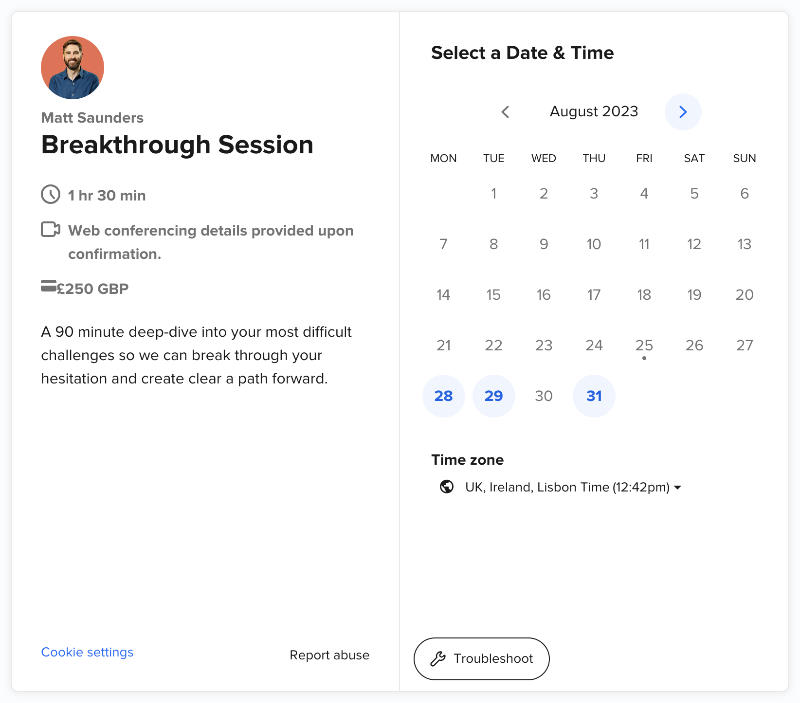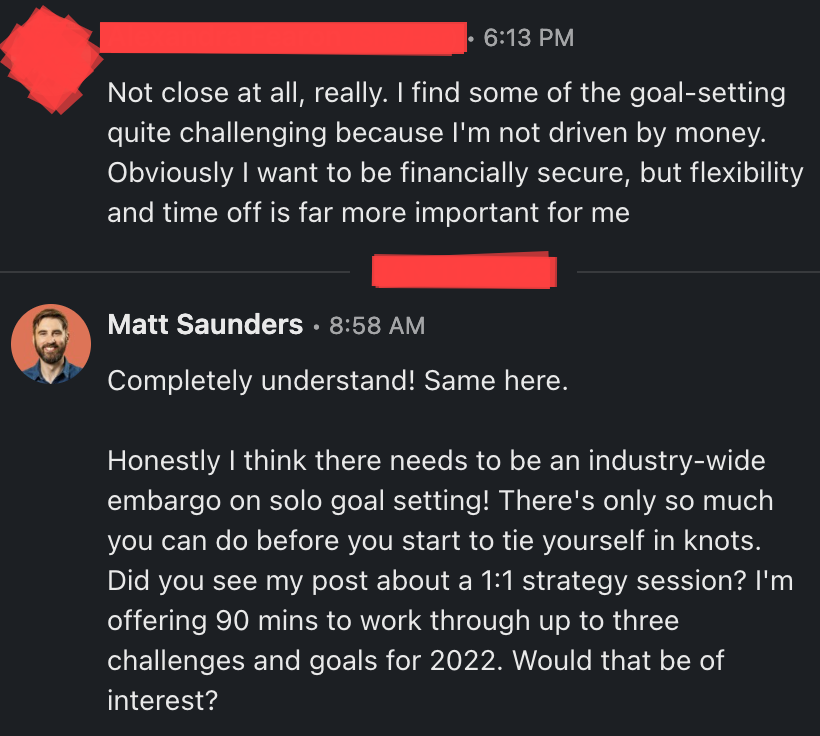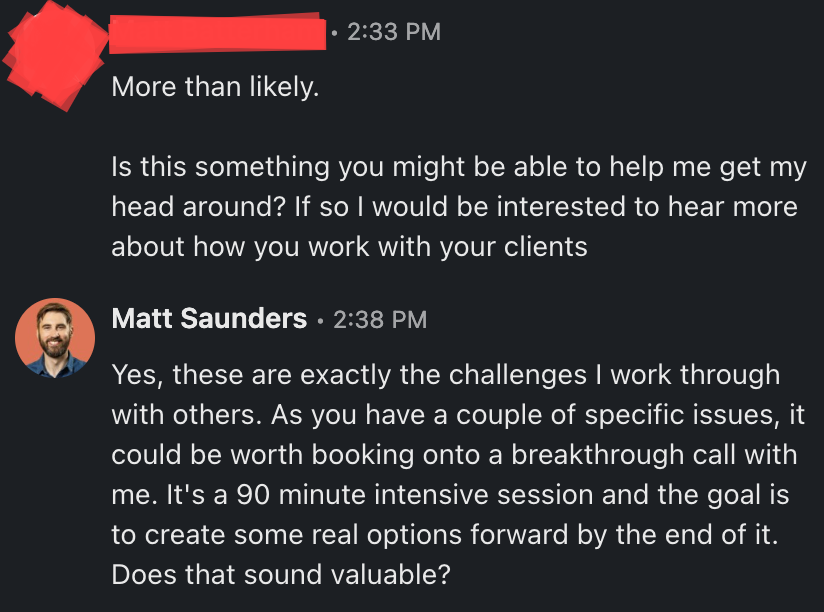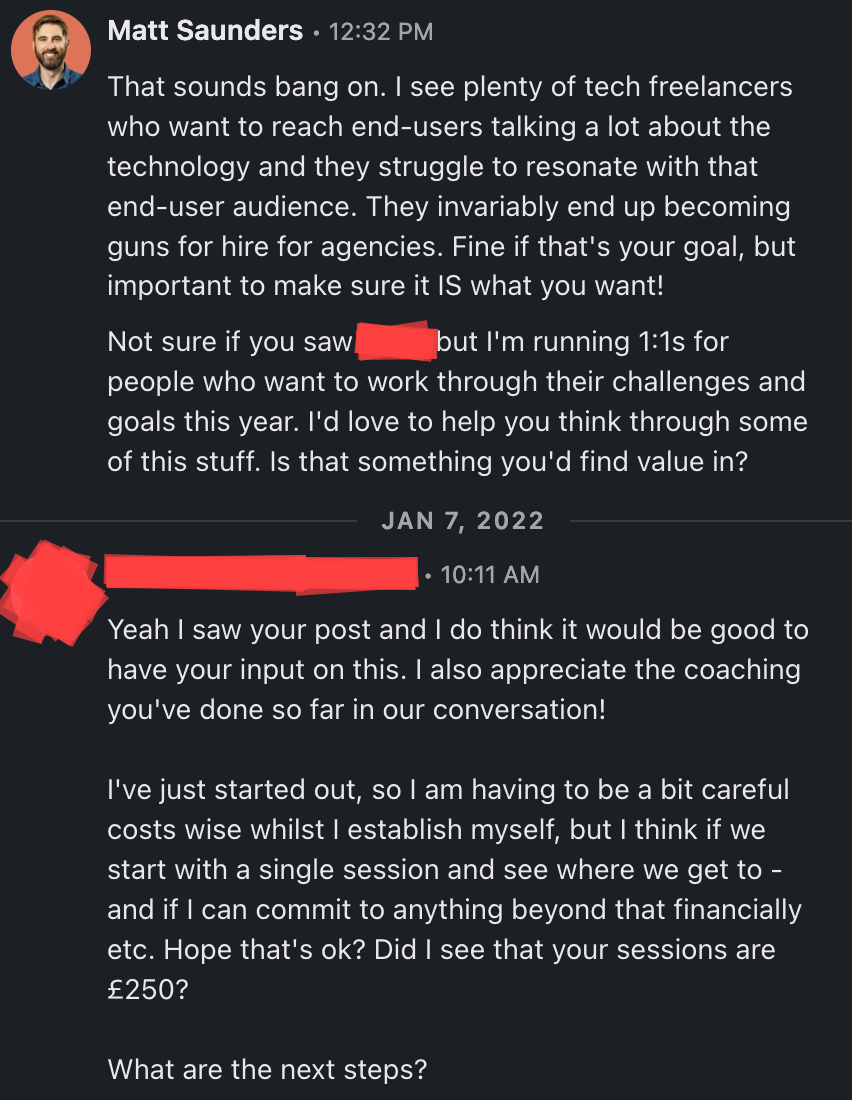Aug 24
/
Matt Saunders
How to Consistently Sell Your Power Hours
Do you want to sell power hours through your website, but nobody ever books with you? Here's how to fix that.
Let me guess: you've got a nice page on your website dedicated to selling power hours for £99. You've posted about it on social media a few times, but nobody is biting (or maybe you get the odd nibble).
Perhaps you've even factored your power hour income into your cashflow forecast? "If I can just sell 10 of these a month, that's my rent taken care of..."
It's a nice thought, isn't it? But, as I'm sure you will have learned, it's not quite that easy! 😕
Full disclosure: I no longer offer power hours (more on that later) but when I did, I managed to crack the code. I repeatedly sold 90 minute blocks for £250 to my audience. Here's everything I've learned...
First things first: your attitude

I need to start here because it's where most people go wrong.
Power hours sound great because they feel like easy cash. But if you're thinking this way, it is contributing to at least 90% of the reason why you hardly ever sell any.
Your attitude to power hours must be service-centred. In other words, you must truly believe that you can drive massive value for your clients before you try to enrol them. Your attitude must be one of overwhelming service to your clients, and not about adding extra revenue to your business. I know this might sound counterintuitive, but trust me. The energy you take into your marketing will determine the results you get.
Nobody is going to pay you so you can pay your rent. They pay for a specific outcome and to feel a certain way. I know this sounds obvious, but we all need a reminder of it from time to time!
Now let's take a look at some of the common reasons why you might struggle to sell power hours.
Power hours sound great because they feel like easy cash. But if you're thinking this way, it is contributing to at least 90% of the reason why you hardly ever sell any.
Your attitude to power hours must be service-centred. In other words, you must truly believe that you can drive massive value for your clients before you try to enrol them. Your attitude must be one of overwhelming service to your clients, and not about adding extra revenue to your business. I know this might sound counterintuitive, but trust me. The energy you take into your marketing will determine the results you get.
Nobody is going to pay you so you can pay your rent. They pay for a specific outcome and to feel a certain way. I know this sounds obvious, but we all need a reminder of it from time to time!
Now let's take a look at some of the common reasons why you might struggle to sell power hours.
Why it's so hard to sell a power hour

Above: screen grab of my breakthrough session sold through Calendly
The reason I can write this article with such confidence is because I tried and failed to sell power hours many times before I hit my stride. Here are the common reasons you'll fail to make the sale.
#1 "Know, like and trust" is non-existent
In order for anyone to buy anything there must be a degree of trust established within the relationship. This is why cold pitching is so risky - people buy from people and in order to get the sale, you must demonstrate that you are a trustworthy person. And in a cold pitch, we know nothing about the person trying to sell to us.
Trust starts by consistently signalling your values and expertise. And one of the main reasons we fail to sell power hours is because people don't know us well enough. Imagine for a moment that a prominent figure like Bill Gates popped onto LinkedIn and offered power hours. I'm sure he could sell an hour of his time for £10,000 and still book out his entire day.
Therefore, you must build your personal brand, consistently demonstrating your knowledge, expertise and personality. This is how trust is established, and it will help you significantly when it comes to selling power hours.
Trust starts by consistently signalling your values and expertise. And one of the main reasons we fail to sell power hours is because people don't know us well enough. Imagine for a moment that a prominent figure like Bill Gates popped onto LinkedIn and offered power hours. I'm sure he could sell an hour of his time for £10,000 and still book out his entire day.
Therefore, you must build your personal brand, consistently demonstrating your knowledge, expertise and personality. This is how trust is established, and it will help you significantly when it comes to selling power hours.
#2 Low value perception
The problem with selling a small block of time is that deep down, many prospective clients will be thinking "can I really get that much done in an hour? Wouldn't it be better to hold on to my £99?"
They are right to be skeptical. Because here's the thing: you're not actually selling time; you are selling an outcome.
Your power hour must make a promise. It needs to visualise an outcome for the buyer that is so powerful, the fee itself and the time associated with it feels insignificant. As I said earlier, this requires getting into a truly customer-centric mindset. When you see from their vantage point, you can see exactly where they want to go, and create a high value proposition that they can't wait to buy into.
They are right to be skeptical. Because here's the thing: you're not actually selling time; you are selling an outcome.
Your power hour must make a promise. It needs to visualise an outcome for the buyer that is so powerful, the fee itself and the time associated with it feels insignificant. As I said earlier, this requires getting into a truly customer-centric mindset. When you see from their vantage point, you can see exactly where they want to go, and create a high value proposition that they can't wait to buy into.
#3 No clear onboarding or delivery process
Assuming you have built know, like and trust and you have created a high value perception for your power hour, a poor onboarding experience should not really stand in the way.
That being said, it is always a good idea to make this stuff as seamless as possible. Your power hour offer must communicate:
Along with these basic housekeeping procedures, you must also work to alleviate their concerns.
Will I get what I need? Can I get a refund if not? What if I need to cancel on the day?
The way you frame your power hour must not only stoke an inspired feeling, but it must offer a path of no resistance. Speak to these concerns, and your conversion rate will increase.
Now that we have looked at a few reasons why selling power hours is tough, here's how to break through and start selling yours, consistently.
That being said, it is always a good idea to make this stuff as seamless as possible. Your power hour offer must communicate:
- How to book
- When the payment will be taken
- What happens right after booking
- What they must do to prepare for the power hour
- What happens after the power hour
Along with these basic housekeeping procedures, you must also work to alleviate their concerns.
Will I get what I need? Can I get a refund if not? What if I need to cancel on the day?
The way you frame your power hour must not only stoke an inspired feeling, but it must offer a path of no resistance. Speak to these concerns, and your conversion rate will increase.
Now that we have looked at a few reasons why selling power hours is tough, here's how to break through and start selling yours, consistently.
How to sell power hours consistently
Sales in the B2B service space fundamentally come from conversations. This is the process through which a potential buyer becomes aware of what you offer, expresses an interest in buying it, then ultimately makes the purchase.
Your social posts can start a conversation. Your website can start a conversation. But do you know what else can start a conversation? You.
It's time to stop waiting for people to find you, and for you to goto them.
Pretty much all of my power hour sales have come from a conversation I started by sending a cold message on LinkedIn (see that link for conversation starter examples).
And once you get into a chat, there's a two-step process to broadly follow to sell more power hours:
Just like a doctor diagnoses a problem before prescribing a solution, you should adopt a similar mentality to sales. You need to understand if the person could actually benefit from buying your power hour first. If so, you can make an offer. Here are some DM examples from LinkedIn...
Your social posts can start a conversation. Your website can start a conversation. But do you know what else can start a conversation? You.
It's time to stop waiting for people to find you, and for you to goto them.
Pretty much all of my power hour sales have come from a conversation I started by sending a cold message on LinkedIn (see that link for conversation starter examples).
And once you get into a chat, there's a two-step process to broadly follow to sell more power hours:
- Diagnose
- Prescribe
Just like a doctor diagnoses a problem before prescribing a solution, you should adopt a similar mentality to sales. You need to understand if the person could actually benefit from buying your power hour first. If so, you can make an offer. Here are some DM examples from LinkedIn...

In the above example I sought to understand their position, empathise, then make the offer.

In the above example the person had questions about what the power hour would cover. I told them exactly how it would run and they came back with the magic response: when can we book this in?

In the above example I diagnosed a couple of issues then assured them we would focus on and fix them in the session, because I had already done the same countless times for previous clients.

The above power hour booking came from a curious conversation about where the person is currently at and where they'd like to get to.
In all of the above DM examples I committed to a diagnostic process. I was curious and not pushy. I only offered the power hour if I felt I could genuinely help and if the time seemed right.
A few even went on to spend £thousands with me over a longer term engagement. Which leads me into my final thought...
In all of the above DM examples I committed to a diagnostic process. I was curious and not pushy. I only offered the power hour if I felt I could genuinely help and if the time seemed right.
A few even went on to spend £thousands with me over a longer term engagement. Which leads me into my final thought...
Should you sell a power hour?

So, this piece has been focused on how to sell power hours. But I want to end on the question of whether they're right for you.
What I have found as a service provider and coach is that people are generally seeking transformation, in some large or small way, to their business. Even the most powerful of power hours have limited capacity to deliver this, simply down to the fact that transformation comes from repetition over time.
Power hours are great for transactional impact. In other words, if you can teach somebody a valuable skill or fix a very specific problem during a power hour, more power to you!
But if your business, like mine, values deeper and longer term relationships, power hours might not be the way to go. You can use them to start a more meaningful relationship, but be totally clear about this up-front. Don't claim you can fix their world in one hour. It's easy to overpromise here, which will damage any potential future relationship.
To illustrate this, I used to sell website design but before writing a proposal, I would sometimes offer my clients a paid discovery session with their main team. This would enable us to scope out the project properly. Reasonable clients would happily pay a few hundred £ for my time to lead this session and get what we need in order to create the proposal. This is like a power hour but sold as a paid scoping session. The key difference is that it was framed as a starting piece of the puzzle, not the whole thing.
So, whether you decide to sell power hours to not, my key takeaways here are to make the process as simple as possible, clearly state the benefits and remain in a customer-centric mindset the whole time.
Do this, and you'll increase your sales across the board.
What I have found as a service provider and coach is that people are generally seeking transformation, in some large or small way, to their business. Even the most powerful of power hours have limited capacity to deliver this, simply down to the fact that transformation comes from repetition over time.
Power hours are great for transactional impact. In other words, if you can teach somebody a valuable skill or fix a very specific problem during a power hour, more power to you!
But if your business, like mine, values deeper and longer term relationships, power hours might not be the way to go. You can use them to start a more meaningful relationship, but be totally clear about this up-front. Don't claim you can fix their world in one hour. It's easy to overpromise here, which will damage any potential future relationship.
To illustrate this, I used to sell website design but before writing a proposal, I would sometimes offer my clients a paid discovery session with their main team. This would enable us to scope out the project properly. Reasonable clients would happily pay a few hundred £ for my time to lead this session and get what we need in order to create the proposal. This is like a power hour but sold as a paid scoping session. The key difference is that it was framed as a starting piece of the puzzle, not the whole thing.
So, whether you decide to sell power hours to not, my key takeaways here are to make the process as simple as possible, clearly state the benefits and remain in a customer-centric mindset the whole time.
Do this, and you'll increase your sales across the board.

Copyright © 2024
Company number 11599252 | VAT number 308863483
Company number 11599252 | VAT number 308863483
